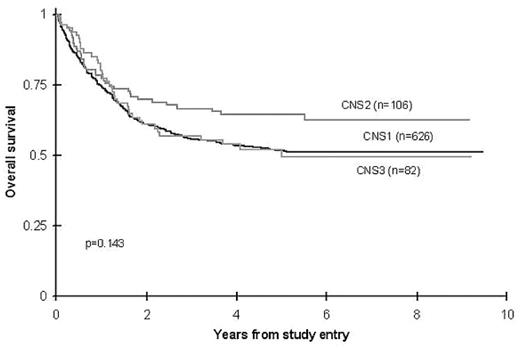Abstract
Introduction: The presence of disease in the central nervous system (CNS) in pediatric acute myeloid leukemia (AML) is often thought to confer a worse prognosis. This study examined the outcome of children with AML who had CNS disease at diagnosis.
Methods: Patients enrolled on Children’s Oncology Group protocols 2891 (N=836)and 2961 (N=901) being treated for de novo AML were classified for the presence of CNS disease at diagnosis as: CNS1 (less than 5 WBC in the CSF with no blasts), CNS2 (less than 5 WBC in the CSF with blasts) or CNS3 (5 or more WBC in the CSF with blasts). CNS disease at diagnosis was then analysed for survival, patient characteristics and outcome using univariate analysis. Patients on these protocols were treated with intrathecal chemotherapy and not radiation therapy for their CNS disease.
Results: For both AML protocols, the overall survival and event free survival were highest in patients with CNS2 disease but this was not significantly different from the survival of the CNS1 and CNS3 patients.
Overall survival from 2891 study entry for all de novo patients
Overall survival from 2961 study entry for all de novo patients
Patients with CNS 2 and 3 disease were of significantly lower median age than CNS1 patients (p=0.001 in 2891 and p=0.005 in 2961). There was a significantly higher WBC count at diagnosis (p=0.001 in both studies), presence of hepatomegaly (p=0.001 in both studies), presence of splenomegaly (p=0.003 in 2891 and p=0.001 in 2961), FAB M2 morphology (p=0.001 in both studies) and FAB M4 morphology (p=0.001 in both studies) in patients with CNS2 and 3 disease compared to CNS 1 patients. Also, CNS2 and 3 patients had a significantly higher incidence of abnormal chromosome 16 (p=0.002 in 2891 and p=0.001 in 2961). In protocol 2891 significantly more CNS2 and 3 patients had hyperdiploid cytogenetics compared to CNS1 patients (p=0.016), and in protocol 2961 there were significantly more patients with t(8;21) in the CNS1 group (p=0.007). In terms of overall outcome, there was a significantly higher incidence of isolated CNS relapse in patients with CNS3 disease at diagnosis in the 2891 protocol (p=0.001), and in patients with both CNS2 and 3 disease at diagnosis in the 2961 protocol (p=0.001).
Conclusion: Patients with CNS disease at diagnosis have similar survival to those without CNS disease, although they have an increased incidence of isolated CNS relapse. More aggressive CNS directed therapy may be warranted in this patient population.
Author notes
Disclosure: No relevant conflicts of interest to declare.



This feature is available to Subscribers Only
Sign In or Create an Account Close Modal